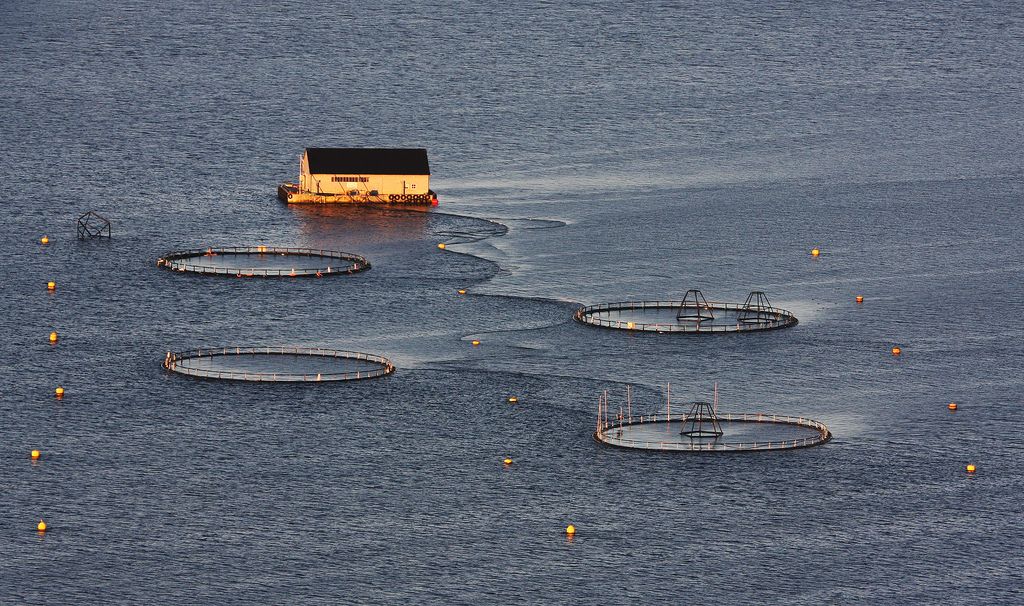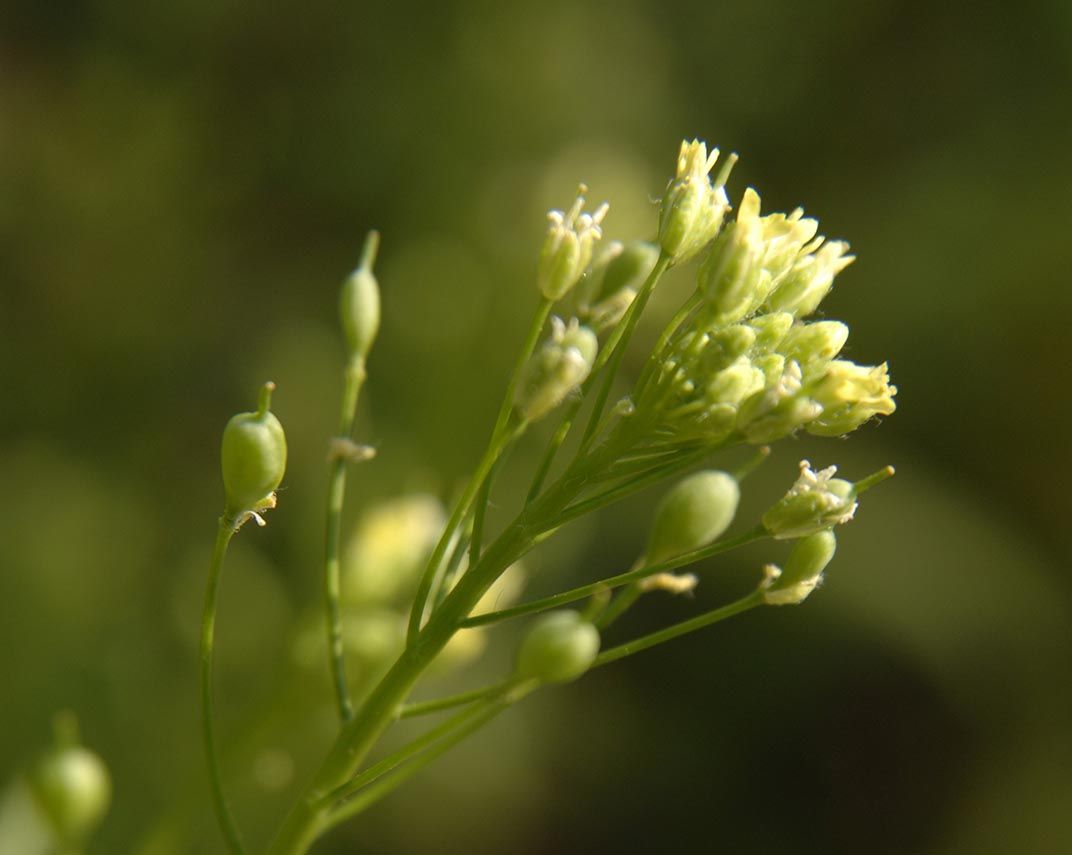Fish Oil Could (One Day) Come From Plants
A field trial of genetically modified oilseed plants that can make fish oil hopes to help fish farming become more sustainable
/https://tf-cmsv2-smithsonianmag-media.s3.amazonaws.com/filer/1c/04/1c048557-620a-4ef9-abc1-a93063bd6650/6108414903_b431e4c320_o.jpg)
In a field in the English countryside, a new source of fish oil is growing. Rothamsted Research in Hertfordshire, U.K., recently began a field trial of camelina flax (Camelina sativa) plants genetically modified to produce long chain omega-3 fatty acids—the primary component of “fish oil.”
The field trial gained approval in April from the Department for Environment, Food, and Rural Affairs (DEFRA), the U.K. administrative body that regulates genetically modified crops, and the researchers will harvest their first crop this month or next. For the U.K., this is a big step; in fact, it’s the first trial of its kind. DEFRA has only approved five genetically modified (GM) plants for field trials, and this is the first with enhanced nutrient value.
While some are wary of such genetically modified organisms making it into the human diet, others see it as part of a trend in using GM plants to make nutrient-rich food and medicinal products more sustainably. In this case, GM camelina could make fish farming more sustainable and fish more nutritious.
See, fish don’t actually make fish oil. What we call fish oil are long chains of omega-3 polyunsaturated fatty acids. Eicosapentaenoic acid (EPA) and docosahexaenoic acid (DHA) are the two most important fatty acids to human diets and have been linked with healthy brain functioning and reducing inflammation (although it's unclear as yet whether these benefits lead to healthier hearts, as many have claimed). Algae and fungi naturally produce these long chains, and fish eat the microbes or smaller organisms that ate the microbes.
In the ocean, oils make their way up the food chain into bigger fish. So a wild fish will have fish oils, accumulated from the food it ate.
In fish farms, however, it’s a different story. “The big problem is that fish farming is dependent on these fish oils as an input,” says Jonathan Napier, lead scientist on the Rothamsted trial.
Without the wealth of oil-rich food sources in the ocean, a farmed fish is “not going to grow up looking like a real fish or tasting like a real fish. It simply won’t have the right fatty acids in its oils,” says Colin Lazarus, a biologist at the University of Bristol in the U.K. who is not affiliated with the current trial. Without the oil, farmed fish would also be less nutritious, as they would lack omega-3 fatty acids.
Algae and fugal populations are messy and hard to maintain on a large scale, so unfortunately, the easiest place to get fish oil is from other fish. About a million tons of fish oil are harvested annually from the ocean, and about 80 percent of that goes to fish farms and gets mixed into farm feed.
If it seems a bit ridiculous to harvest fish from the ocean to feed fish oil to farmed fish, you’re right. As wild fish populations dwindle, more and more of the fish consumed around the globe comes from farms. But for that fish to be nutritious, it needs the wild fish.

How can resource managers stop this self-defeating style? The answer, some scientists think, lies in agriculture.
Agriculture requires pretty basic resources—sunlight, water, and fertilizer—and already has infrastructure to produce oils such as sunflower oil and canola oil. So why not genetically engineer plants to produce fish oil?
“Genetic modification could provide a more sustainable route to growing fish for human consumption because hoovering up the seas, taking up all the fish in the sea to grind up masses of it in order to get fish oil to grow fish in captivity is not a sustainable exercise,” says Lazarus.
But how does one make a plant that makes fish oil? Getting a plant to make omega-3 fatty acids is just a matter of cutting and pasting all of the right genes from algae into a plant, Lazarus explains. To produce the desired fatty acid, you need to figure out which genes produce an acid with the correct number of carbons and chemical bonds in all the right places.
“If you’ve got the right genes, then the plant will happily do it for you,” says Lazarus. For example, in 2004, Lazarus’s lab cut and pasted algae genes into an Arabidopsis, a small flowering plant frequently used in tests to observe biological reactions. After it was spliced together, the whole plant produced low levels of long-chain omega-3 and omega-6 fatty acids.
The team at Rothamsted has spent the last decade trying to build a more efficient plant fish oil factory. “It was a bit like trying to find all the parts to make your device and then once you’ve got all the parts then you could assemble them,” says Napier.
Camelina plants made for an ideal vessel, given their quick lifecycle and for the fact that they don’t typically cross hybridize or breed with common canola crop plants—meaning that genes engineered into the camelina are less likely to genetically contaminate wild plant populations. They’ve managed to genetically modify their camelina plants to contain seven genes from algae, so they’re likely to produce high levels of both EPA and DHA.
These algal genes also required some modification to make it compatible with the plant. This is because when genes are transcribed in a cell, some organisms have certain preferences when reading genetic codes. So the researchers tweaked genes to contain genetic building blocks favored by camelina, rather than those favored by algae.
“It’s almost like smoothing the language to make it flow better in the host,” says Napier. This makes omega-3 production in the plant more efficient, yielding more fatty acids. Then, using a special promoter gene, the researchers were able to focus production of these fatty acids within the plants’ seeds, making harvesting a lot easier
Growing in the greenhouse, these camelina plants produce seeds that contain 25 percent omega-3 oils (12 percent EPA and 14 percent DHA) and 75 percent regular vegetable oil. Since fish farms often mix vegetable oil into their feed along with fish oil to cut costs, it’s a useful combination. Researchers at the University of Stirling are currently testing the feed from the Rothamsted greenhouse in fish farms.
The next logical step is to test how the plants fare when grown in a field rather than a greenhouse. This year the field trial includes about 1000 plants in 100 square meter plot, and, if all goes well, next year they will double the volume.

The trial will run each growing season through 2017. Success would be a plant that grows the exact same way outside as it does in the greenhouse—and produces the same amount of omega-3s.
If everything goes smoothly, the plants could produce omega-3 fatty acids for mainstream fish farm use in the next ten years. The plants could even become a source for human nutritional supplements—a booming industry even though the science on their effectiveness isn't fully in yet.
That said, obviously not everyone sees eye to eye on genetic engineering. Some fear the crops could come with undiscovered health risks or allergies. And others feel it doesn’t truly solve aquaculture sustainability issues.
"This would simply replace one problem, over-consumption of fish stocks to feed fish, with another, additional demand for land for feed for animals, rather than for growing food for humans,” Helena Paul, director of the group GM Freeze, told The Guardian in January when plans for the trial were first announced.
The Rothamsted group certainly isn’t the only one working on crops that can produce omega-3s. A team in Australia is engineering camelina and canola plants to produce omega-3 fatty acids. In the U.S., Monsanto has developed on a soybean plant that produces an omega-3 called stearidonic acid. Other groups are looking into linseed and Indian mustard plants as potential hosts, as well.
What’s more, genetic technology is pretty flexible. Beyond fish oil, it could someday be used to make other oils and nutritional products, researchers speculate. Using plants to produce things like pharmaceuticals and even oral vaccines is even a possibility.
“If you can get a plant to produce the antigen that produces the vaccine, you might find it easier to transport the plant or the plant product for people to simply eat,” says Lazarus.
Picture it: Crops chock full of measles vaccine. Of course, such developments are a long way off and would require extensive clinical and environmental field-testing before becoming anything close to reality.
But to researchers, the potential is alluring. A key first step? A fruitful harvest when Rothamsted researchers pick their fish oil seeds.
/https://tf-cmsv2-smithsonianmag-media.s3.amazonaws.com/accounts/headshot/Screen_Shot_2014-01-27_at_12.05.16_PM.png)
/https://tf-cmsv2-smithsonianmag-media.s3.amazonaws.com/accounts/headshot/Screen_Shot_2014-01-27_at_12.05.16_PM.png)